INTRODUCTION
Approximately 20 students take part in the Sustainability Academy at Opunake High School, one of the choices of a fortnightly academy day. Students are guided to come up with innovative ideas to help benefit the world, whether it is locally or globally. Lead teachers, Peter Clement and Andrea Hooper create ample opportunities for students to explore their local environment through outdoor recreation, workshops and volunteer service. Student voice is an important part of this academy and students are encouraged to pursue ideas and actions they feel strongly and passionately about.
HOW IT ALL STARTED
The project initially started out with the idea of raising free range hens, so that the students could produce eggs for their town.
“We wanted to grow our own hens, so that we could minimise the packaging used for the eggs and also decrease the amount of fossil fuels used whilst distributing the eggs. By producing our own eggs, we would not end up with egg cartons, nor will we be using petrol to drive to the supermarkets.” (Brydee Hunt)
EXPLORING ALTERNATIVES
The idea of getting ex battery hens was suggested. The students spent time researching battery hen farming practices in New Zealand and found out some very sobering facts:
- Battery Hens are raised in cages no bigger that a piece of A4 paper.
- They cannot stretch their wings.
- They have to constantly stand on wire mesh that is sloping day and night.
- The wire mesh cuts their feet and the small wire enclosures rub the feathers off their bodies, leaving blood blisters to form.
- There is a strong smell of ammonia in the air, as well as the waste that the hens produce.
- As soon as the hens are born a part of their beak is sheared off with a hot iron.
ACTION
The students began to contact sources that rescued battery hens. This was a frustrating process as most never replied or were not interested in helping the students. However perseverance paid off;
“I found a lady that was located in Rotorua who re-homed ex battery hens. We got on the phone with Kelly and talked about our project. When I asked Kelly if we could adopt four hens off her, she then said that she was more than happy to donate them to us since it was a school project, ( instead of their normal price of $15.00, that goes towards rehoming the birds.) The next hurdle was that Kelly and the hens lived four hours and thirty seven minutes away. Kelly mentioned the pet bus could most possibly transport our hens for us. The lady that usually “pet buses” Kelly’s hens, said that she would transport out hens for half price which will cost us $30.00.” (Brydee Hunt)
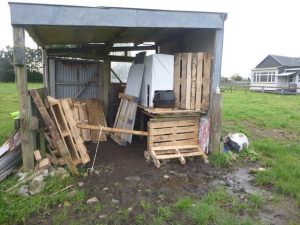
The derelict shed with pallets ready for the project.
The chickens were scheduled to arrive in mid-July. Now there was preparation work to be done. Where will they live? The students now needed to provide a warm space with a lot of free-range foraging space for the chickens. Mr Clement, who lived opposite the school, offered the derelict shed in his back field for the students to convert into a chook motel!
The group of students visited their local Farmlands and Farmsource depots and collected pellets to make raised nesting boxes. For extra insulation, they wrapped the nesting boxes in plastic sheeting, which they had kept after builders had been working at the school. The students also built chook ladders so that the chickens could easily access the nesting boxes.

The ramps made for the chickens to access the nesting box.
Fixing up the shed for free became a goal for the students. They worked with Mr Clement to source 100% recycled materials to create an ideal space.
They used the following:
- Doors from the school – removed during renovation.
- An old trampoline, to be used as a chicken run.
“We found the trampoline run idea on google and we thought it is an awesome idea to give your hens space outdoors.”
- An old caravan water tank.
“Another idea of ours was to create a water system that was sustainable. We thought of making a system so that the water trickles off the roof into a drinking tank for the hens. “

Reusing an old trampoline for the chicken run.
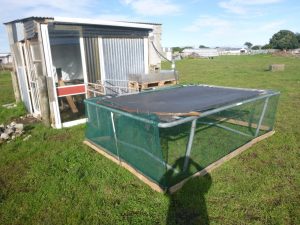
The completed chicken motel.
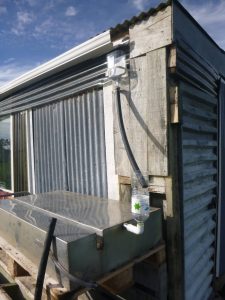
The rainwater collection system for drinking water.
COMMUNITY SUPPORT
The students became so committed to this project that one student set up a blog page so that the community could be kept up to date with its progress.
This blog generated so much interest locally that support was offered in many different forms:
- Two local women, reading about how battery hens had hardly any feathers, knitted six chicken cardigans to keep them warm
- Local cafe ‘Sugar Juice’ offered food scraps.
- Sacks of chicken food were donated at the High School office.
- Offers of more chickens came from community members

Kiara and Jack welcome one of the chickens.
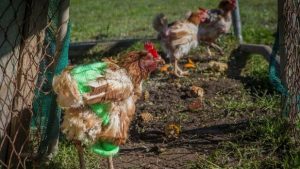
One of the new arrivals in her new jumper.
A NEW BEGINNING
After weeks of hard work and preparation the hens finally arrived. The students were shocked at the condition of the hens. All were missing feathers around the neck and chest areas and most had raw patches of skin. However, this reinforced the importance of their project and made them feel thankful that they were able to provide these hens with the chance of a better life.
AND NOW
A couple of months later, the hens were well and truly rehabilitated. Their feathers had now grown back and they were foraging and roaming like true free-range hens.
“They’re so fluffy and inquisitive,” Hunt said. “I came over here one day during the holidays and they were all in here and when they saw us they came running out. They’re very happy.”
The hens have made the kids more aware of what goes on behind the scenes in egg production.
“Since getting the hens and making them free range we only buy free-range eggs now and we support that. For us as a group, none of us knew what was happening. We didn’t really know much about the difference between caged hens and free-range hens.”
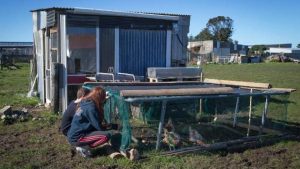
The completed chicken run with inhabitants.
Banner photo: The chickens at Opunaki High School seem happy with their new accommodation.